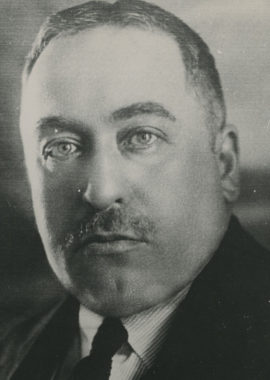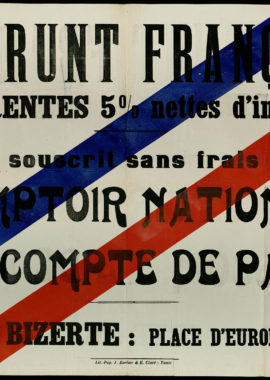It was at a relatively quiet time in international relations that Horace Finaly, Managing Director of Banque de Paris et des Pays-Bas, wrote to André Tardieu, Minister of Public Works, in October 1926. His short letter mentions the return of US investors to the French bond* market, which had been struggling for several months due to the extreme instability of the French franc. The letter provided an update on the situation.
Who is André Tardieu ?
A former colleague of Georges Clemenceau, André Tardieu had attended the Lycée Condorcet in Paris with Horace Finaly. He became a journalist specialised in diplomacy and was close to the French foreign ministry for many years.
During the first world war, after serving in the army, he turned to politics. When the United States entered the war in April 1917, André Tardieu was sent to Washington by the government to coordinate Franco-American relations and ensure French industrial and military needs were met. He was therefore responsible for the supply of goods and weapons to France during the war.

André Tardieu was close to Georges Clemenceau, in particular during the Paris Peace Conference in 1919, and remained in positions of power until the establishment of the Cartel of the Left in 1924. The Cartel of the Left broke up in 1926 when the monetary crisis saw the franc collapse against other currencies (it lost nine-tenths of its value against sterling, for example). Raymond Poincaré returned to power and appointed André Tardieu as a minister.
Why did Horace Finaly write to André Tardieu?
Horace Finaly wrote to André Tardieu not in his capacity as Minister of Public Works, but due to his deep knowledge of the American world of finance.
The financial crisis in France since the start of 1926 had caused investors to mistrust securities issued by French government entities and companies. It was important to reassure the markets that France could stabilise its currency. This was necessary to be able to enjoy easy access to the US bond market. It was therefore not surprising that André Tardieu was asked to intervene in the United States and use his contacts and connections to benefit French interests.

The letter is an exchange between Horace Finaly and André Tardieu – one of Paris’ leading bankers and one of the leading experts in the US markets.
The scope of the letter
The letter is more than a simple correspondence of a few lines, it reveals several important points.
First, the close relationship between the leaders of Banque de Paris et des Pays-Bas and politicians in the French Third Republic. Besides the Minister of Finance of the time, who was none other than Raymond Poincaré himself [the crisis meant that the Prime Minister had to manage this portfolio], Horace Finaly did not hesitate to inform his contacts in other ministries.
The letter also shows the important role played by Banque de Paris et des Pays-Bas in US finance. Maurice Boyer, the bank’s representative in New York until the end of the second world war, had used his influence to promote the bank’s interests on this market in the making since 1919.

Banque de Paris et des Pays-Bas was regularly lead manager for government and corporate bond placements. Its influence in New York enabled it to place bonds easily on the US market, which was already one of the most important global markets. Horace Finaly considered it important to announce France’s return to the global financial markets after a period of uncertainty and turmoil, and to indicate that Banque de Paris et des Pays-Bas was ready to play a key role.
Three years later, the Wall Street crash in October 1929 lessened the Bank’s ambitions on the US market, but it remained active in the country.
Another saga
Also in 1926, another forerunner of BNP Paribas Group besides Banque de Paris et des Pays-Bas was already well established in the United States: Comptoir National d’Escompte de Paris (CNEP). The Comptoir was set up in San Francisco in 1877 and in New York from 1903. It forged a strong, lasting presence in the United States by creating the French American Banking Corporation (FABC) with two US banks, in July 1919. But that’s another story!
What is a bond ?
bond is a piece of debt issued by a company, a local authority or a government. When one of these entities wishes to finance itself, the amount required the interventions of many creditors. BNP Paribas forerunners helpeld companies to finance themselves on the financial markets by organising the introduction of securities, as an intermediary.











